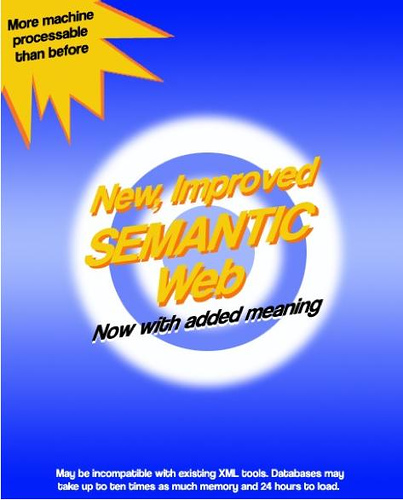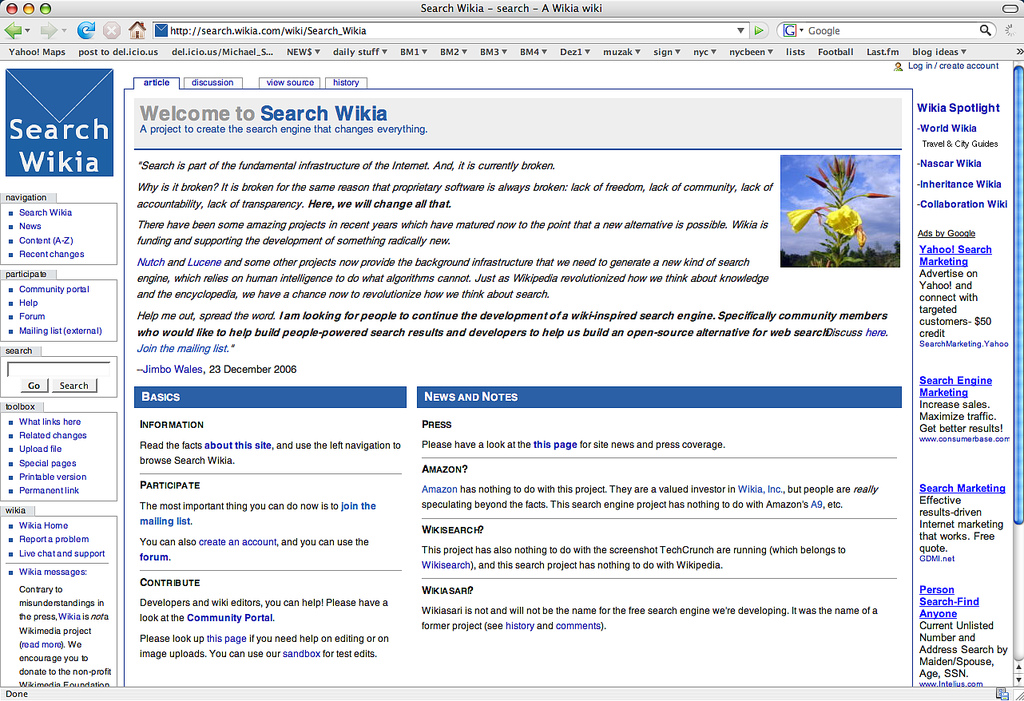






















The Web as a Totalizing System
Increasingly all data is on the Web: a universal information space

The "Web 2.0" is the use of the Web as a platform for applications, a universal computation space
What is the break point for the full realization of the Web as a platform for applications?
Semantic Web research has till recently built a parallel Web instead of aligning the current hypertext Web with the Semantic Web.
Never underestimate the amount of information in HTML
or in databases behind firewalls...
Liberate the data and put it in a common universal format for accessing by our Web applications?

Opposing Methodologies
Peter Norvig: We deal with millions of Web masters who can't configure a server, can't write HTML. It's hard for them to go to the next step.

Microformats: The lower-case semantic web
Shockingly, a large number of web sites are using microformats:
There's even a Dreamweaver plug-in to help authors!
hCal
<span class="vevent"> <p><abbr class="dtstart" title="2006-12-05">December 5-</abbr> <abbr class="dtend" title="2006-12-07">7th</abbr> </b> At <b><span class="summary"&rt;XML 2006</span></b> (<span class="location">Boston, MA USA</span>) for a presentation on "Social Semantic Mashups".</span>
XFN
<li><a href="http://www.w3.org/People/Connolly/" rel="colleague met">Dan Connolly</a></li> <li> <a href="http://seanmcgrath.blogspot.com/" rel="colleague met">Sean McGrath</a></li> <li><a href="http://www.jclark.com/" rel="colleague">James Clark</a></li>
Microformats are centralized data formats for different types of data, often (nearly) isomorphic to already widely adopted non-Web standards:

Too many services replicate the same sort of data....what if you have a Friendster, a Myspace, and a Twtter account?
Photo by Jon Hicks
The main problem with microformats is that they put your data into HTML, but you have no standard way to get the data out.
Except really hairy XSLT style-sheets such as Suda's x2v...
A further problem is that they cannot be validated easily. You can mix hCard and hCal and there's no way to guarantee you will interpret it correctly.
Domain-specific: You can not make a microformat for just anything!
Demo of Microformat Browsing using TailsThe Semantic Web is a solution in search of a problem: Data Integration
URIs can be used as a universal (globally-unique) identifier, like a foreign key in a database
RDF is a natural format for combining up any sort of data with any other sort of data!, since the URI preserves the identity of the data.
Due to the open world assumption and being based on links, it is an extremely flexible data format that should be able to capture data from relational databases, microformats, and more...
For each popular microformat vocabulary we are in the midst of manufacturing an isomorphic RDF model.
Format |
Domain |
Model |
Mapping |
Status |
DC |
Document/Content Metadata |
usable (Sep 2005 testing status) |
||
Social Networks |
FOAF * |
usable |
||
People |
? |
? |
||
Calendars and Events |
usable |
|||
Opinions, Ratings and Reviews |
in progress |
|||
Licenses |
? |
|||
Tags, Keywords, Categories |
? |
GRDDL (Gleaning Resource Descriptions from Dialects of Languages) is a simple and low-cost way to boostrap RDF out of XML and in particular XHTML data by explicitly labelling transformations from RDF to XML.
GRDDL consists of three components:<html xmlns="http://www.w3.org/1999/xhtml"> <head profile="http://www.w3.org/2003/g/data-view"> <link rel="stylesheet" type="text/css" href="homepage.css"/> <link rel="schema.DC" href="http://purl.org/dc/elements/1.1/"/> <link rel="transformation" href="http://www.w3.org/2002/12/cal/glean-hcal.xsl"/> <meta name="ICBM" content="055.94270, -003.18599"/> <meta name="DC.title" content="Harry Halpin's Homepage"/> <meta name="DC.creator" content="Harry Halpin"/> <meta name="DC.language" content="en"/> <title>Harry Halpin's Homepage</title> </head> ... <body> </body> </html>
No Transformation Links - just go to the namespace document!
In RDF, OWL, RDF Schema:
<rdf:RDF
xmlns:rdf="http://www.w3.org/1999/02/22-rdf-syntax-ns#"
xmlns:dataview="http://www.w3.org/2003/g/data-view#">
<rdf:Description rdf:about="http://www.w3.org/2004/01/rdxh/p3q-ns-example">
<dataview:namespaceTransformation
rdf:resource="http://www.w3.org/2004/01/rdxh/grokP3Q.xsl"/>
</rdf:Description>
</rdf:RDF>
In XML Schema:
<xsd:schema xmlns:xsd="http://www.w3.org/2001/XMLSchema"
xmlns="http:.../Order-1.0"
targetNamespace="http:.../Order-1.0"
version="1.0"
...
xmlns:data-view="http://www.w3.org/2003/g/data-view#"
data-view:transformation="http://www.w3.org/2003/g/embeddedRDF.xsl" >
<xsd:element name="Order" type="OrderType">
<xsd:annotation
<xsd:documentation>This element is the root element.</xsd:documentation>
</xsd:annotation>
...
<xsd:annotation>
<xsd:appinfo>
<rdf:RDF xmlns:rdf="http://www.w3.org/1999/02/22-rdf-syntax-ns#">
<rdf:Description rdf:about="http://www.w3.org/2003/g/po-ex">
<data-view:namespaceTransformation
rdf:resource="grokPO.xsl" />
</rdf:Description>
</rdf:RDF>
</xsd:appinfo>
</xsd:annotation>
...
The vast majority of the organizational information is in Excel Spreadsheets

<?mso-application progid="Excel.Sheet"?>
<Workbook
xmlns="urn:schemas-microsoft-com:office:spreadsheet"
xmlns:o="urn:schemas-microsoft-com:office:office"
xmlns:x="urn:schemas-microsoft-com:office:excel"
xmlns:dt="uuid:C2F41010-65B3-11d1-A29F-00AA00C14882"
xmlns:ss="urn:schemas-microsoft-com:office:spreadsheet"
xmlns:html="http://www.w3.org/TR/REC-html40"
xmlns:grddl="http://www.w3.org/2003/g/data-view#"
grddl:transformation="xcel-mf2rdf.xsl">
<!-- ... -->
<CustomDocumentProperties xmlns="urn:schemas-microsoft-com:office:office">
<profile dt:dt="string">http://www.mnot.net/2005/08/xcel-mf</profile>
<namespace dt:dt="string">ahttp://example.org/attendance/</namespace>
</CustomDocumentProperties>
<!-- ... -->
<Worksheet ss:Name="Sheet1">
<Table>
<!-- ... -->
<Row ss:Index="3">
<!-- ... -->
<Cell ss:StyleID="s26"><Data ss:Type="String">2006-04</Data><NamedCell
ss:Name="Header"/><NamedCell ss:Name="date"/></Cell>
<!-- ... -->
</Row>
<!-- ... -->
<Row>
<Cell ss:StyleID="s25"><Data ss:Type="String">Robin</Data><NamedCell
ss:Name="name"/><NamedCell ss:Name="Header"/></Cell>
<!-- ... -->
<Cell><Data ss:Type="String">n</Data><NamedCell ss:Name="present"/><NamedCell
ss:Name="Data"/></Cell>
<!-- ... -->
</Row>
<!-- ... -->
</Table>
<!-- ... -->
</Worksheet>
</Workbook>
<?xml version="1.0" encoding="UTF-8"?> <rdf:RDF xmlns:rdf="http://www.w3.org/1999/02/22-rdf-syntax-ns#" xmlns="ahttp://example.org/attendance/"> <!-- ... --> <rdf:Description> <name>Robin</name> <date>2006-04</date> <present>n</present> </rdf:Description> <!-- ... --> </rdf:RDF>
Now merge with other spreadsheets!
<?xml version="1.0" encoding="UTF-8"?> <rdf:RDF xmlns:rdf="http://www.w3.org/1999/02/22-rdf-syntax-ns#" xmlns="ahttp://example.org/events/"> <rdf:Description> <date>2006-03</date> <label>choose new meeting location</label> </rdf:Description> </rdf:RDF>
PREFIX att: <ahttp://example.org/attendance/>
PREFIX ev: <ahttp://example.org/events/>
SELECT ?name WHERE
{
?event ev:label "choose new meeting location" .
?event ev:date ?date .
?attendance att:date ?date .
?attendance att:name ?name .
?attendance att:present "y" .
}
Which would give the following results:
| name |
| Jane |
| David |
The only way to make progress against the centralization of the web in services like Google is to make data open and decentralized.
Will companies put their sensitive data in Google applications?
But they want social and collaborative aspects of Google Web applications?
The Semantic Web can deliver social and collaborative results in a decentralized manner
Microsoft can deliver to customers by providing GRDDLs for their XML formats, preventing migration to centralized servers.
Can we build off of social search engines?
How about microformats, as in GRDDL and Technorati's Microformat Search?

Can we provide trusted search, through Semantic Rules and policy?
Can we use RDF as a transport layer amongst decentralized search engines?
In concert with Wikia search? Semantic Wikipedia?
Why shouldn't the Semantic Web tackle the world's biggest problem: Search on the Web, in a decentralized manner?

How can we exploit natural occurring "semantic" HTML markup with a minimum of NLP?
There is no reason why Javascript has to be the dominant language of the Web 2.0 - procedural with attendant security and modelling problems
XSLT is functional, but cannot actually invert from RDF back to XSLT, control the entire XML Processing Model (DTD default attributes, XInclude), lacks interoperation with Web Services and native use of Semantic Web logic.
The Curry-Howard Isomorphism which states that for every logical form there is a corresponding programming language
One can convert between functional programming languages and logic, such that we can conceive of a program as steps in a logical proof. - could this be useful to the SemWeb?